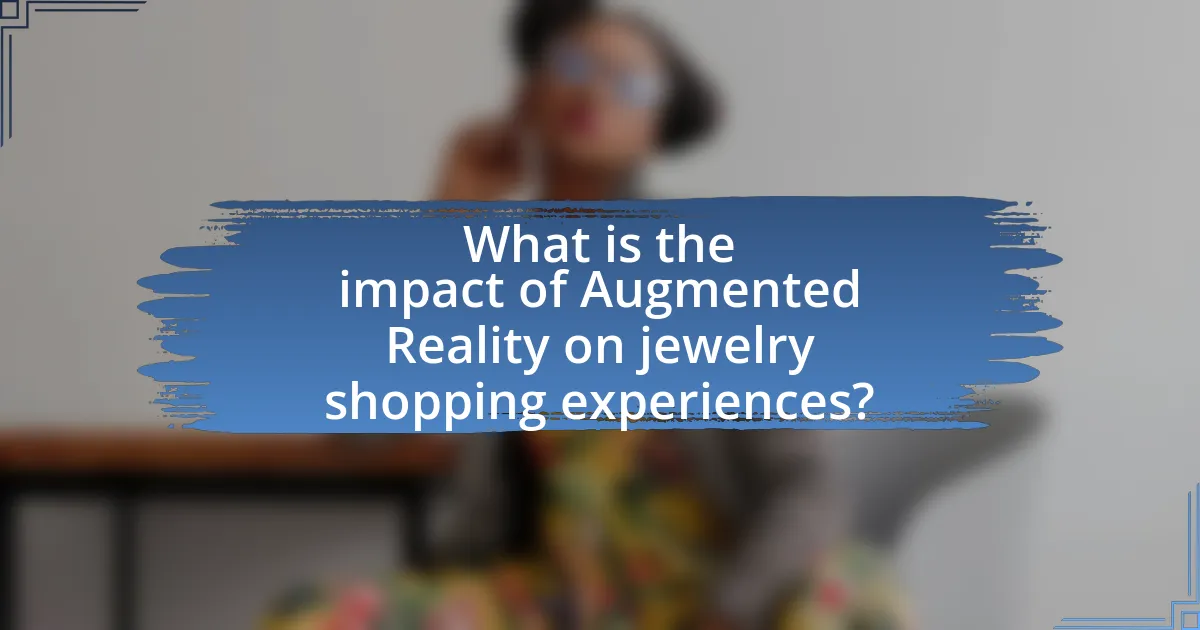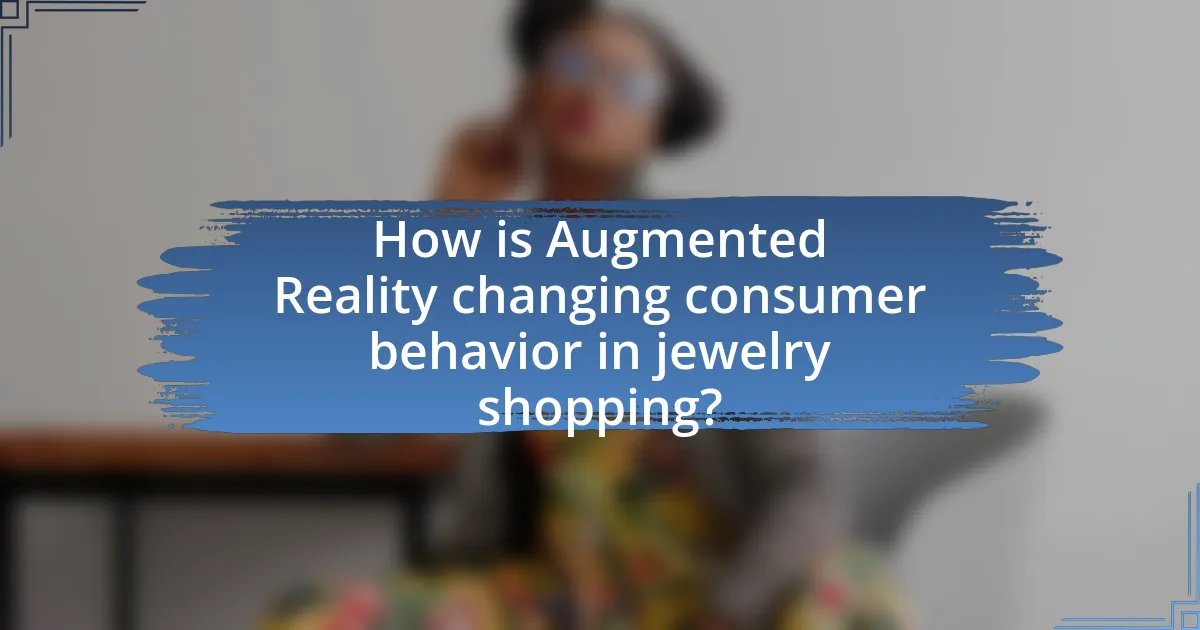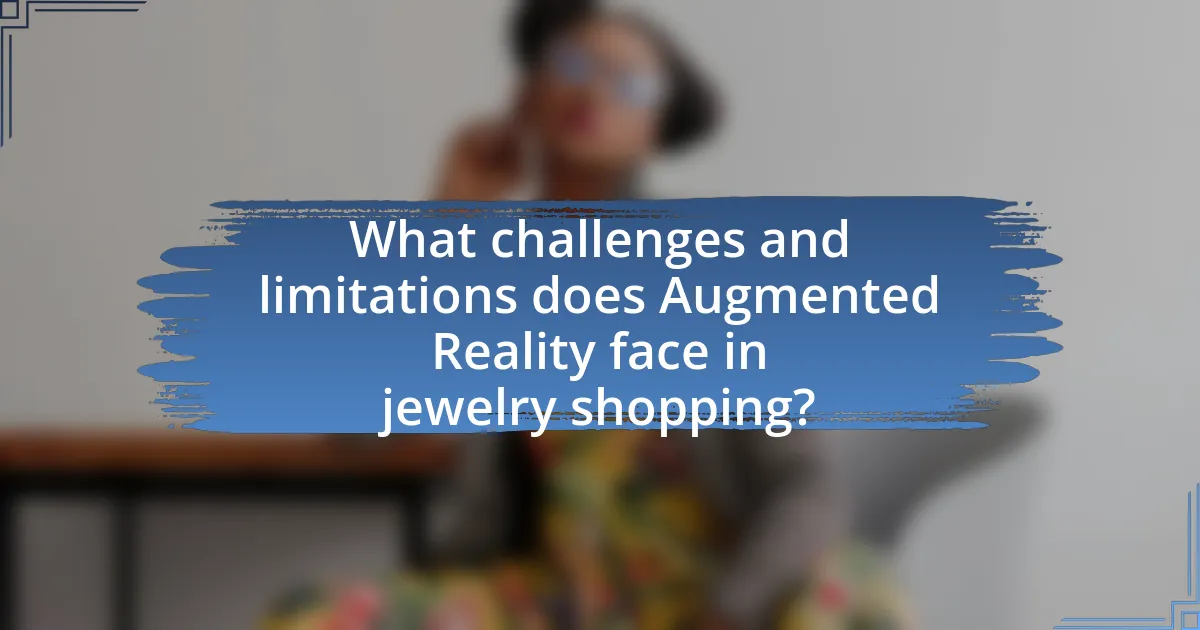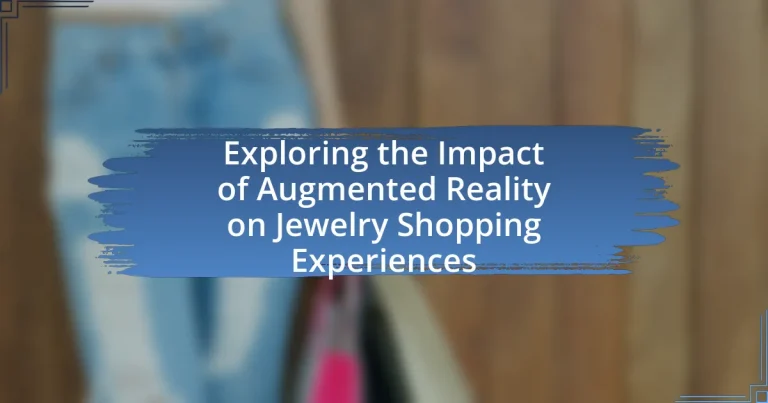The article explores the impact of Augmented Reality (AR) on jewelry shopping experiences, highlighting how AR technology enhances customer engagement and satisfaction by allowing virtual try-ons of jewelry items. Key findings indicate that 40% of consumers are more likely to purchase jewelry after using AR features, as it reduces uncertainty and fosters confidence in buying decisions. The article discusses the technologies involved in AR, the benefits for both consumers and retailers, and the challenges faced in implementing AR solutions in the jewelry sector. Additionally, it addresses strategies for improving user experience and educating consumers about AR applications in jewelry shopping.

What is the impact of Augmented Reality on jewelry shopping experiences?
Augmented Reality (AR) significantly enhances jewelry shopping experiences by allowing customers to visualize how pieces will look on them before making a purchase. This technology enables users to try on various jewelry items virtually through their smartphones or AR devices, increasing engagement and satisfaction. A study by Deloitte found that 40% of consumers are willing to pay more for a product if they can experience it through AR, indicating that AR not only improves the shopping experience but also drives sales. Furthermore, AR reduces the uncertainty associated with online purchases, as customers can see realistic representations of jewelry, leading to higher conversion rates and lower return rates.
How does Augmented Reality enhance the jewelry shopping process?
Augmented Reality enhances the jewelry shopping process by allowing customers to virtually try on jewelry items before making a purchase. This technology provides an interactive experience, enabling shoppers to visualize how different pieces look on them in real-time, which can significantly reduce the uncertainty associated with online purchases. According to a study by Deloitte, 40% of consumers expressed a preference for retailers that offer AR experiences, indicating that this technology can lead to higher customer satisfaction and increased sales.
What technologies are involved in Augmented Reality for jewelry?
Augmented Reality (AR) for jewelry involves several key technologies, including computer vision, depth tracking, and 3D modeling. Computer vision enables the recognition of real-world objects and environments, allowing virtual jewelry to be accurately placed in a user’s view. Depth tracking technology measures the distance between the camera and objects, ensuring that the virtual jewelry appears at the correct scale and perspective. Additionally, 3D modeling is essential for creating realistic representations of jewelry pieces, which can be rendered in real-time for users to visualize how the items would look when worn. These technologies collectively enhance the shopping experience by providing interactive and immersive ways for consumers to engage with jewelry products.
How do these technologies improve customer engagement?
Augmented reality (AR) technologies improve customer engagement by providing immersive and interactive shopping experiences that enhance product visualization. AR allows customers to virtually try on jewelry, enabling them to see how pieces look on themselves in real-time, which increases their confidence in purchasing decisions. According to a study by Deloitte, 40% of consumers are more likely to make a purchase when they can visualize products in their own environment, demonstrating that AR significantly boosts engagement and conversion rates in retail settings.
What are the key benefits of using Augmented Reality in jewelry shopping?
The key benefits of using Augmented Reality (AR) in jewelry shopping include enhanced visualization, increased customer engagement, and improved decision-making. AR allows customers to virtually try on jewelry items, providing a realistic view of how pieces will look on them, which can lead to higher satisfaction and reduced return rates. According to a study by Deloitte, 40% of consumers reported that AR experiences significantly influenced their purchasing decisions, demonstrating the effectiveness of AR in enhancing the shopping experience. Additionally, AR can create interactive and immersive experiences that keep customers engaged longer, ultimately driving sales and brand loyalty.
How does Augmented Reality influence customer decision-making?
Augmented Reality (AR) significantly influences customer decision-making by enhancing the shopping experience through interactive visualization. AR allows customers to virtually try on jewelry, which increases their confidence in purchasing decisions. A study by Poushneh and Vasquez-Parraga (2017) found that 70% of consumers reported a higher likelihood of purchasing jewelry after using AR applications, as they could visualize how items would look on them in real-time. This immersive experience reduces uncertainty and fosters emotional connections with products, ultimately leading to increased sales and customer satisfaction.
What advantages does Augmented Reality offer to retailers?
Augmented Reality (AR) offers retailers significant advantages, including enhanced customer engagement, improved product visualization, and increased sales conversion rates. By allowing customers to virtually try on products, such as jewelry, AR creates an interactive shopping experience that can lead to higher satisfaction and reduced return rates. A study by Deloitte found that retailers using AR saw a 40% increase in conversion rates, demonstrating the effectiveness of this technology in driving sales. Additionally, AR can provide personalized recommendations, further enhancing the shopping experience and fostering customer loyalty.

How is Augmented Reality changing consumer behavior in jewelry shopping?
Augmented Reality (AR) is significantly transforming consumer behavior in jewelry shopping by enhancing the interactive experience and enabling virtual try-ons. This technology allows consumers to visualize how jewelry pieces will look on them in real-time, leading to increased engagement and confidence in purchasing decisions. A study by Deloitte found that 40% of consumers are more likely to make a purchase after using AR features, highlighting its effectiveness in influencing buying behavior. Additionally, AR reduces the uncertainty associated with online shopping, as customers can see a realistic representation of the product before committing to a purchase, thereby decreasing return rates and increasing customer satisfaction.
What factors contribute to the adoption of Augmented Reality by consumers?
The factors contributing to the adoption of Augmented Reality (AR) by consumers include enhanced user experience, increased engagement, and perceived value. Enhanced user experience arises from AR’s ability to provide interactive and immersive environments, allowing consumers to visualize products in real-time, which is particularly beneficial in sectors like jewelry shopping. Increased engagement is driven by the novelty and interactivity of AR applications, which capture consumer attention and encourage exploration of products. Perceived value is influenced by the convenience and personalization that AR offers, enabling consumers to make informed purchasing decisions by trying on jewelry virtually before buying. Research indicates that 61% of consumers prefer retailers that offer AR experiences, highlighting its impact on consumer behavior and adoption rates.
How does user experience affect the acceptance of Augmented Reality?
User experience significantly influences the acceptance of Augmented Reality (AR) by determining how intuitive, engaging, and satisfying the technology feels to users. Positive user experiences, characterized by ease of use, effective feedback, and immersive interactions, lead to higher acceptance rates of AR applications. For instance, a study by Javornik (2016) published in the Journal of Retailing and Consumer Services found that users who reported enjoyable and seamless interactions with AR applications were more likely to adopt and recommend these technologies. This correlation highlights that enhancing user experience is crucial for fostering acceptance of AR in various contexts, including jewelry shopping.
What role does personalization play in consumer engagement with Augmented Reality?
Personalization significantly enhances consumer engagement with Augmented Reality (AR) by creating tailored experiences that resonate with individual preferences. When consumers interact with AR applications in jewelry shopping, personalized features such as customized product recommendations and virtual try-ons increase their emotional connection to the products. Research indicates that 80% of consumers are more likely to make a purchase when brands offer personalized experiences, demonstrating that personalization in AR not only captures attention but also drives conversion rates. This tailored approach fosters a sense of ownership and satisfaction, ultimately leading to higher consumer loyalty and repeat purchases in the jewelry sector.
Why are consumers more likely to purchase jewelry through Augmented Reality?
Consumers are more likely to purchase jewelry through Augmented Reality (AR) because AR enhances the shopping experience by allowing users to visualize how jewelry looks on them in real-time. This technology provides a more interactive and personalized experience, which increases consumer confidence in their purchase decisions. According to a study by Deloitte, 40% of consumers reported that AR experiences significantly influenced their buying decisions, as they felt more engaged and informed about the products. Additionally, AR reduces the uncertainty associated with online shopping, leading to higher conversion rates and customer satisfaction.
What psychological effects does Augmented Reality have on consumers?
Augmented Reality (AR) significantly influences consumers’ psychological states by enhancing engagement, increasing emotional attachment, and improving decision-making. Research indicates that AR can create immersive experiences that lead to higher levels of consumer involvement and satisfaction. For instance, a study published in the Journal of Retailing and Consumer Services found that AR applications in retail settings can evoke positive emotions and increase the likelihood of purchase by 30%. This heightened emotional response is attributed to AR’s ability to provide interactive and personalized experiences, which foster a sense of ownership and connection to products. Additionally, AR reduces the uncertainty often associated with online shopping by allowing consumers to visualize products in real-time, thereby enhancing their confidence in purchasing decisions.
How does Augmented Reality reduce the uncertainty in online jewelry purchases?
Augmented Reality (AR) reduces uncertainty in online jewelry purchases by allowing customers to visualize how jewelry will look on them in real-time. This technology enables users to superimpose digital images of jewelry onto their own images or live video feeds, providing a more accurate representation of size, style, and fit. Research indicates that 70% of consumers feel more confident in their purchase decisions when they can see how a product looks on them before buying, as reported in a study by the Harvard Business Review. By enhancing the shopping experience with interactive and immersive features, AR effectively bridges the gap between online and in-store shopping, leading to increased customer satisfaction and reduced return rates.

What challenges and limitations does Augmented Reality face in jewelry shopping?
Augmented Reality (AR) faces several challenges and limitations in jewelry shopping, primarily including technological constraints, user experience issues, and accuracy in representation. Technological constraints involve the need for high-quality graphics and processing power, which can limit accessibility on lower-end devices. User experience issues arise from the potential for AR applications to be cumbersome or unintuitive, leading to frustration among users. Additionally, accuracy in representation is critical; if the AR visualization does not accurately reflect the jewelry’s size, color, or sparkle, it can mislead customers, impacting their purchasing decisions. These challenges hinder the effectiveness of AR in enhancing the jewelry shopping experience.
What technical barriers exist for implementing Augmented Reality in jewelry retail?
The primary technical barriers for implementing Augmented Reality (AR) in jewelry retail include high development costs, limited hardware compatibility, and challenges in achieving realistic rendering of jewelry. High development costs arise from the need for specialized software and skilled personnel to create AR applications tailored for jewelry. Limited hardware compatibility is an issue because not all consumers possess devices capable of supporting advanced AR features, which can restrict user access. Additionally, achieving realistic rendering of intricate jewelry designs requires advanced graphics technology, which can be difficult to implement effectively, leading to potential discrepancies between virtual and physical products. These barriers hinder the widespread adoption of AR in the jewelry retail sector.
How do device compatibility issues affect user experience?
Device compatibility issues significantly hinder user experience by preventing seamless access to augmented reality features in jewelry shopping. When users encounter incompatibility with their devices, they may experience crashes, slow performance, or inability to utilize AR functionalities, which can lead to frustration and abandonment of the shopping process. For instance, a study by Statista in 2022 indicated that 40% of users reported dissatisfaction due to technical issues related to device compatibility while using AR applications. This dissatisfaction can result in decreased engagement and lower conversion rates for retailers, highlighting the critical importance of ensuring compatibility across a wide range of devices to enhance user experience in augmented reality environments.
What are the costs associated with developing Augmented Reality solutions?
The costs associated with developing Augmented Reality (AR) solutions typically range from $50,000 to over $500,000, depending on the complexity and features of the application. Development costs are influenced by factors such as the technology stack used, the level of interactivity required, and the duration of the project. For instance, a simple AR application may cost around $50,000, while a more sophisticated solution with advanced features like real-time tracking and 3D modeling can exceed $500,000. Additionally, ongoing maintenance and updates can add to the total expenditure, often estimated at 15-20% of the initial development cost annually.
How can retailers overcome the challenges of Augmented Reality in jewelry shopping?
Retailers can overcome the challenges of Augmented Reality (AR) in jewelry shopping by investing in high-quality 3D modeling and user-friendly interfaces. High-quality 3D models enhance the realism of virtual try-ons, which is crucial for customer satisfaction; a study by Deloitte found that 40% of consumers are more likely to purchase jewelry after experiencing AR try-ons. Additionally, retailers should focus on integrating AR seamlessly into their existing platforms, ensuring that the technology is accessible and easy to use, as user experience directly impacts engagement and conversion rates. By addressing these technical aspects, retailers can significantly improve the effectiveness of AR in enhancing the jewelry shopping experience.
What strategies can be employed to enhance the effectiveness of Augmented Reality?
To enhance the effectiveness of Augmented Reality (AR) in jewelry shopping experiences, integrating user-friendly interfaces is essential. User-friendly interfaces facilitate seamless navigation and interaction, which can significantly improve customer engagement and satisfaction. Research indicates that 70% of users prefer applications that are easy to use, leading to increased adoption rates (Source: Nielsen Norman Group). Additionally, incorporating personalized recommendations based on user preferences can enhance the shopping experience, as studies show that personalized experiences can increase conversion rates by up to 20% (Source: McKinsey & Company). Furthermore, ensuring high-quality graphics and realistic rendering of jewelry items can create a more immersive experience, as consumers are more likely to make purchases when they can visualize products accurately.
How can retailers educate consumers about using Augmented Reality effectively?
Retailers can educate consumers about using Augmented Reality (AR) effectively by providing interactive tutorials and demonstrations that showcase AR features in a practical context. For instance, retailers can create engaging video content that illustrates how to use AR applications to visualize jewelry on themselves, enhancing the shopping experience. Research indicates that 61% of consumers prefer retailers that offer AR experiences, highlighting the importance of education in maximizing user engagement and satisfaction. By integrating AR into their marketing strategies and offering hands-on experiences in-store or online, retailers can significantly improve consumer understanding and utilization of AR technology in jewelry shopping.
What best practices should retailers follow when integrating Augmented Reality into jewelry shopping?
Retailers should prioritize user experience, ensuring that Augmented Reality (AR) applications are intuitive and easy to navigate. A seamless integration of AR into jewelry shopping enhances customer engagement and satisfaction, as evidenced by a study from Deloitte, which found that 40% of consumers are more likely to purchase jewelry when they can visualize it through AR. Additionally, retailers should provide high-quality 3D models of their jewelry, as realistic representations increase consumer trust and reduce return rates. Furthermore, incorporating social sharing features allows customers to share their AR experiences, which can drive word-of-mouth marketing and attract new customers. Lastly, retailers must ensure that AR technology is compatible with various devices to reach a broader audience, as a report by Statista indicates that over 80% of consumers use smartphones for shopping.


